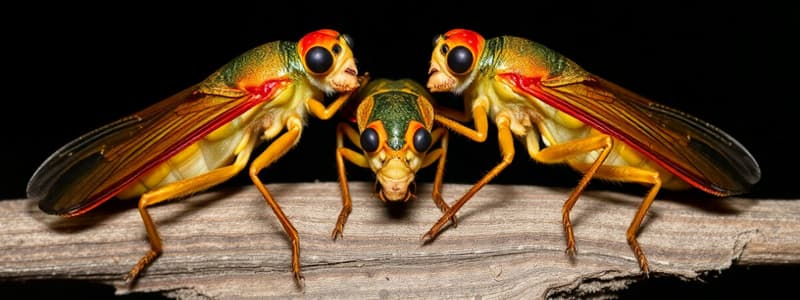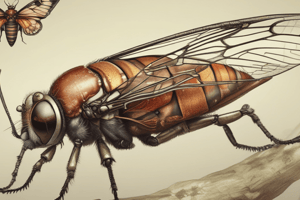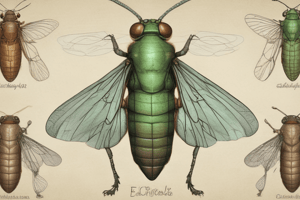Podcast
Questions and Answers
The simultaneous emergence of Brood XIX and Brood XIII is considered rare primarily because:
The simultaneous emergence of Brood XIX and Brood XIII is considered rare primarily because:
- the life cycles of periodical cicadas are usually synchronized across different broods to maximize reproductive success.
- cicadas typically emerge during alternating years to avoid competition for resources.
- climate change has disrupted the natural emergence patterns of cicada broods in the United States.
- the prime-numbered life cycles of 13 and 17 years only coincide every few centuries. (correct)
Researchers propose that cicadas emerge after prime-numbered years (13 or 17) as an evolutionary strategy to:
Researchers propose that cicadas emerge after prime-numbered years (13 or 17) as an evolutionary strategy to:
- synchronize their emergence with specific environmental conditions that occur predictably every 13 or 17 years.
- maximize their exposure to sunlight, which is essential for their development and reproduction.
- confuse predators with complex life cycles, preventing them from adapting to cicada emergence. (correct)
- minimize competition among different cicada species during mating seasons.
Based on the information, what is the most significant ecological impact of periodical cicadas?
Based on the information, what is the most significant ecological impact of periodical cicadas?
- They can cause substantial damage to young trees due to egg-laying habits. (correct)
- They serve as a primary food source for a variety of bird species.
- They contribute to soil aeration through their burrowing activities.
- They help control populations of other insect species through predation.
Why do male cicadas produce a high-pitched drone?
Why do male cicadas produce a high-pitched drone?
Assuming the researchers' theory is correct, which predator adaptation would pose the greatest threat to cicadas with a 17-year cycle?
Assuming the researchers' theory is correct, which predator adaptation would pose the greatest threat to cicadas with a 17-year cycle?
Given that Brood XIII and Brood XIX overlap only in Illinois and Iowa during their emergence, what can be inferred about the environmental factors influencing cicada distribution?
Given that Brood XIII and Brood XIX overlap only in Illinois and Iowa during their emergence, what can be inferred about the environmental factors influencing cicada distribution?
If a new species of tree is discovered in an area where periodical cicadas are prevalent, which characteristic would make it most vulnerable to cicada damage?
If a new species of tree is discovered in an area where periodical cicadas are prevalent, which characteristic would make it most vulnerable to cicada damage?
Considering the potential annoyance caused by the cicadas' 90-decibel drone, what strategy would be MOST effective for a community aiming to mitigate the disturbance during the cicada emergence?
Considering the potential annoyance caused by the cicadas' 90-decibel drone, what strategy would be MOST effective for a community aiming to mitigate the disturbance during the cicada emergence?
Flashcards
Periodical Cicadas
Periodical Cicadas
Cicadas that emerge every 13 or 17 years.
Brood XIX
Brood XIX
Brood emerging every 13 years.
Brood XIII
Brood XIII
Brood emerging every 17 years.
Cicada Brood Co-emergence
Cicada Brood Co-emergence
Signup and view all the flashcards
Tree Sap
Tree Sap
Signup and view all the flashcards
Damage to Young Trees
Damage to Young Trees
Signup and view all the flashcards
Cicada Drone
Cicada Drone
Signup and view all the flashcards
Prime Number Emergence
Prime Number Emergence
Signup and view all the flashcards
Study Notes
- Trillions of cicadas will emerge in sixteen US states from Maryland to Oklahoma and Illinois to Alabama.
- Two broods are emerging simultaneously, which is a rare occurrence.
- Brood XIX surfaces every 13 years and comprises four species.
- Brood XIII consists of three species and appears every 17 years.
- The last time this happened was 221 years ago in 1803, and it won't happen again until 2245.
- The cicadas have already begun to emerge in some areas.
- Their numbers are expected to peak for a two-to-three-week period starting mid-May.
- Experts believe that the two broods will come close in many states but will only overlap in Illinois and Iowa.
About Periodical Cicadas
- Periodical cicadas spend most of their lives underground.
- They feed off sap from tree roots.
- The black, shrimp-sized bugs have red, beady eyes.
- They emerge every 13 or 17 years to reproduce, and die soon after.
Why the odd number of years?
- Researchers believe that if the insects appeared after an even number of years, like 12 or 16, they would become predictable prey for predators with 2, 4, and 8-year lifespans.
- Because 13 and 17 are prime numbers, any predator dependent on the cicadas must match those lifespans to survive.
- How the cicadas know when it is time to emerge is unknown.
Impact of Cicadas
- Cicadas are harmless to humans.
- Their massive swarms can be daunting and a nuisance.
- The loud, high-pitched drone of male cicadas, which reaches 90 decibels, can be extremely annoying.
- The insects can cause significant damage to young trees.
- Female cicadas seek out slender twigs or vines to lay their eggs.
- The incisions they make to deposit their eggs often sever the food supply, causing the branch to wilt.
- Mature trees can withstand this damage.
- Experts suggest covering young fruit or nursery trees with nets during the cicada onslaught, or they will get stunted or killed.
- The adult cicadas die soon after the eggs are laid.
- Their bodies provide a rare feast for animals and nitrogen for growing trees.
- The eggs hatch in 4-6 weeks.
- A new generation of cicadas burrows into the soil to live underground for the next 13 or 17 years.
Studying That Suits You
Use AI to generate personalized quizzes and flashcards to suit your learning preferences.
Description
Trillions of cicadas from Broods XIII and XIX are emerging across 16 US states. This rare simultaneous emergence hasn't occurred since 1803 and won't again until 2245. The cicadas, which spend years underground feeding on tree roots, emerge to reproduce before dying.





